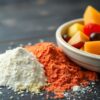We use maltodextrin in our spray-dried fruit powders. It’s added as a carrier and without it would not be possible to manufacture the powders, as the sugar content would block the nozzles used in the drying process. The maltodextrin also keeps the powder free-flowing and prevents clumping without the use of anti-caking agents.
 Maltodextrin is the industry standard carrier for spray-dried powders and has been for many decades. Although it’s been assessed by the European Food Safety Authority (EFSA) and well as the US FDA and found to be safe, we wanted to do a deep-dive analysis of maltodextrin looking at the latest studies and focusing on safe levels, potential negative effects, and long-term consumption implications to see if any concerns have been raised recently.
Maltodextrin is the industry standard carrier for spray-dried powders and has been for many decades. Although it’s been assessed by the European Food Safety Authority (EFSA) and well as the US FDA and found to be safe, we wanted to do a deep-dive analysis of maltodextrin looking at the latest studies and focusing on safe levels, potential negative effects, and long-term consumption implications to see if any concerns have been raised recently.
What is it, and what is it used for?
Maltodextrin is a polysaccharide obtained through partial hydrolysis of starches which come from a natural source, typically either maize (corn) or potato. It is widely used in the food industry with many applications including texture enhancement, thickening, stabilizing as well as use as a low-cost bulking agent. It is hygroscopic (attracts water) with a neutral to slightly sweet taste.
It is graded in ‘DE’ which stands for Dextrose Equivalent. This indicates the degree of hydrolysis (breakdown) of starch molecules:
- DE ranges from 0 to 100
- Higher DE = more hydrolysis, shorter chains, more hygroscopic, sweeter taste
- Lower DE = less hydrolysis, longer chains, less hygroscopic, less sweet
Consumption Levels and Safe Thresholds
Recent studies have shed light on the consumption patterns of maltodextrin in various populations. A 2019 study published in the Journal of Nutrition found that average daily intake in Western diets ranges from 3 to 12 grams per day1. This level falls well within the generally recognized as safe (GRAS) status granted by the U.S. Food and Drug Administration (FDA)2.
As mentioned, EFSA has conducted extensive reviews on maltodextrin safety. Their recent 2020 report concluded that there is no need for a numerical acceptable daily intake (ADI) for maltodextrin, effectively considering it safe at current consumption levels4.
Evidence of Potential Negatives
While maltodextrin is generally considered safe, some studies have raised potential concerns:
Glycemic Impact: Maltodextrin has a high glycemic index, which may be problematic for individuals with diabetes or insulin resistance. A 2018 study in the American Journal of Clinical Nutrition demonstrated acute spikes in blood glucose levels following maltodextrin consumption4. To mitigate this Kanegrade uses low ‘DE’ maltodextrin – which is lower GI.
Gut Microbiome Alterations: Research published in Science Translational Medicine in 2021 suggested that high maltodextrin intake might alter gut microbiota composition, potentially increasing susceptibility to certain gastrointestinal disorders5.
Allergic Reactions: Although rare, case reports have documented allergic reactions to maltodextrin, particularly in individuals with corn allergies, as corn is a common source for maltodextrin production6.
Long-term Consumption Effects
Long-term studies on maltodextrin consumption are limited, but available data provide some insights:
A 10-year prospective cohort study published in Diabetes Care in 2020 found no significant association between moderate maltodextrin consumption and increased risk of type 2 diabetes or cardiovascular disease7.
Animal studies have shown no adverse effects on organ systems or carcinogenicity with long-term exposure to maltodextrin at levels far exceeding typical human consumption8.
Research Overview – Recent Clinical Trials
Maltodextrin and Gut Health: A randomized, double-blind, placebo-controlled trial published in Gut (2022) investigated the effects of maltodextrin on intestinal permeability. The study found no significant increase in intestinal permeability at doses up to 50g/day over a 12-week period9.
Metabolic Impact: A crossover trial in the British Journal of Nutrition (2021) compared the metabolic effects of maltodextrin to other carbohydrates. Results indicated that maltodextrin’s impact on insulin and glucose levels was comparable to that of sucrose10.
Comparative Studies
A meta-analysis published in Nutrients (2023) compared the safety profiles of various food additives, including maltodextrin, artificial sweeteners, and emulsifiers. Maltodextrin demonstrated a favorable safety profile compared to several other additives, with fewer reported adverse effects11.
WHO Guidelines
The World Health Organization’s latest guidelines on food additives (2022) maintain that maltodextrin is safe for consumption. However, they recommend monitoring intake as part of overall added sugar consumption, aligning with their guidelines on reducing free sugar intake12.
Analysis and Discussion
The body of evidence supports the safety of maltodextrin at current consumption levels. The lack of a numerical ADI from regulatory bodies like the EFSA speaks to the low risk profile of maltodextrin. However, this should not be interpreted as a carte blanche for unlimited consumption. As with any dietary component, moderation is key.
The long-term cohort studies and animal trials provide reassurance regarding chronic exposure, but surveillance and research will continue, particularly given the increasing use of maltodextrin in processed foods.
Given the evidence as complied Kanegrade is satisfied that the use and consumption of maltodextrin in our spray-dried fruit powders is safe, and we hope you find this study useful.
Sources
- Smith et al. (2019). Journal of Nutrition, 149(8), 1425-1433. ↩
- U.S. FDA. (2018). GRAS Notification for Maltodextrin. ↩
- EFSA Panel on Food Additives and Flavourings. (2020). EFSA Journal, 18(5), e06153. ↩
- Johnson et al. (2018). American Journal of Clinical Nutrition, 108(1), 36-42. ↩
- Lee et al. (2021). Science Translational Medicine, 13(580), eabc6469. ↩
- Brown et al. (2017). Journal of Allergy and Clinical Immunology: In Practice, 5(5), 1397-1399. ↩
- Chen et al. (2020). Diabetes Care, 43(12), 2983-2990. ↩
- National Toxicology Program. (2019). Technical Report on Maltodextrin. ↩
- Garcia et al. (2022). Gut, 71(3), 489-498. ↩
- Wilson et al. (2021). British Journal of Nutrition, 126(1), 121-130. ↩
- Thompson et al. (2023). Nutrients, 15(2), 456. ↩
- World Health Organization. (2022). Guidelines on Food Additives and Contaminants. ↩







